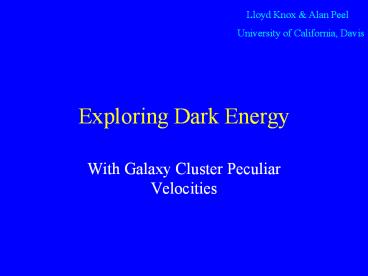Exploring Dark Energy - PowerPoint PPT Presentation
Title:
Exploring Dark Energy
Description:
Cluster velocity velocity correlation functions as probes of dark energy ... With a smaller beam a cluster stands out better against the confusing background ... – PowerPoint PPT presentation
Number of Views:22
Avg rating:3.0/5.0
Title: Exploring Dark Energy
1
Exploring Dark Energy
Lloyd Knox Alan Peel University of California,
Davis
- With Galaxy Cluster Peculiar Velocities
2
Exploring D.E. with cluster
- Philosophy
- Advertisement
- Cluster velocityvelocity correlation functions
as probes of dark energy - POTENT on 100 Mpc scales
3
Dark Energy Parameters
Primordial P(k)
Dark Energy Models
Expansion rate, H(z)
Angular-diameter distance
Luminosity distance
Growth factor
Volume element
Alcock-Paczynski tests with
Calibration parameters
Observed apparent magnitude of SNe Ia
noise
Redshift-space correlations
Dark Energy Does Not Exist In A Vacuum
Evolution of angular clustering
4
DASh (The Davis Anisotropy Shortcut)
Advertisement Advertisement Advertisement
Advertisement Advertisement Advertisement
Advertisement
Kaplinghat, Knox and Skordis (2002)
Dash is a combination of numerical computation
with analytic and semianalytic approximations
which achieve fast and accurate
computation.
About 30 times faster than CMBfast
How fast?
rms error
How accurate?
Applications
- parameter estimation (Knox, Christensen
Skordis 2001, note age and mcmc) - error forecasting
5
On to peculiar velocities
continuity equation
? Peculiar velocities may be helpful in breaking
degeneracies.
6
Growth factor vs. z (normalized to standard CDM)
Time derivative of growth factor vs. z
Dotted lines are for w-0.7. Solid lines are for
w-1
7
Measuring with the SZ effect
Thermal
Kinetic
Sunyaev Zeldovich 1980
8
Kinetic SZ
Thermal SZ
Holzapfel et al. (1997)
9
A possible survey strategy
- Survey large area with large detector array at 30
GHz to find clusters. - Follow up with a smaller array of detectors at
150 GHz and 220 GHz targeting the clusters. (Or
maybe even FTS to get ) - Follow up with optical photometric or
spectroscopic redshifts
10
How well can be measured?
Holzapfel et al. (1997)
Aghanim et al. (2001) Planck will result in
cluster peculiar velocities with errors of 500 to
1,000 km/s.
These large errors are due to Plancks big 5
beam and noisy maps. With a smaller beam a
cluster stands out better against the confusing
background of CMB anisotropy and other clusters.
Haehnelt Tegmark (1996)
Becker et al. (2001)
11
What Are The Expected Signals?
Cluster 1
observer
Cluster 2
12
Expected correlation of radial component of
velocities for clusters with the same redshift
but in different directions
200 km/sec errors (16 micro-K for tau0.01)
100 km/sec errors (8 micro-K for tau0.01)
10 15 30 60
Pierpaoli, Scott White (2001)
13
Expected correlation of radial component of
velocities for clusters in the same direction but
with different redshifts
Note redshifts may need to be determined to
better than .01!
14
Velocity Bias
- Our calculations were for randomly selected
locations in the Universe, but measurements will
be made where clusters are ? bias - Velocity bias not calculated yet (unpublished
work by Sheth) - Easily calculable.
15
POTENT on 100 Mpc scales
We can reconstruct the gravitational potential
from cluster peculiar velocities, as has been
done with galaxy peculiar velocities, but with
much cleaner velocity measurements.
- Why?
- Use as input for better modeling of cluster and
galaxy formation. - Combine with other surveys to directly measure
largescale bias.
Bertschinger Dekel 1989
16
Gravitational Potential Reconstruction
Reconstruction weight
17
Gravitational Potential Reconstruction
From G. Holder
350 km/s
Ignore these
18
Conclusions
- CMB is important for breaking degeneracies
between dark energy parameters and other
parameters - DASh will be available soon.
- Peculiar velocities are sensitive to
- At
- Cluster peculiar velocities can be measured very
well (in principle) for z gt 0.2, well enough to
measure the velocity correlations and reconstruct
the largescale gravitational potential. - Theory/observable relationship is even more
straightforward than other uses of clusters such
as dN/dz.
Thanks to G. Holder and S. Meyer for useful
conversations

